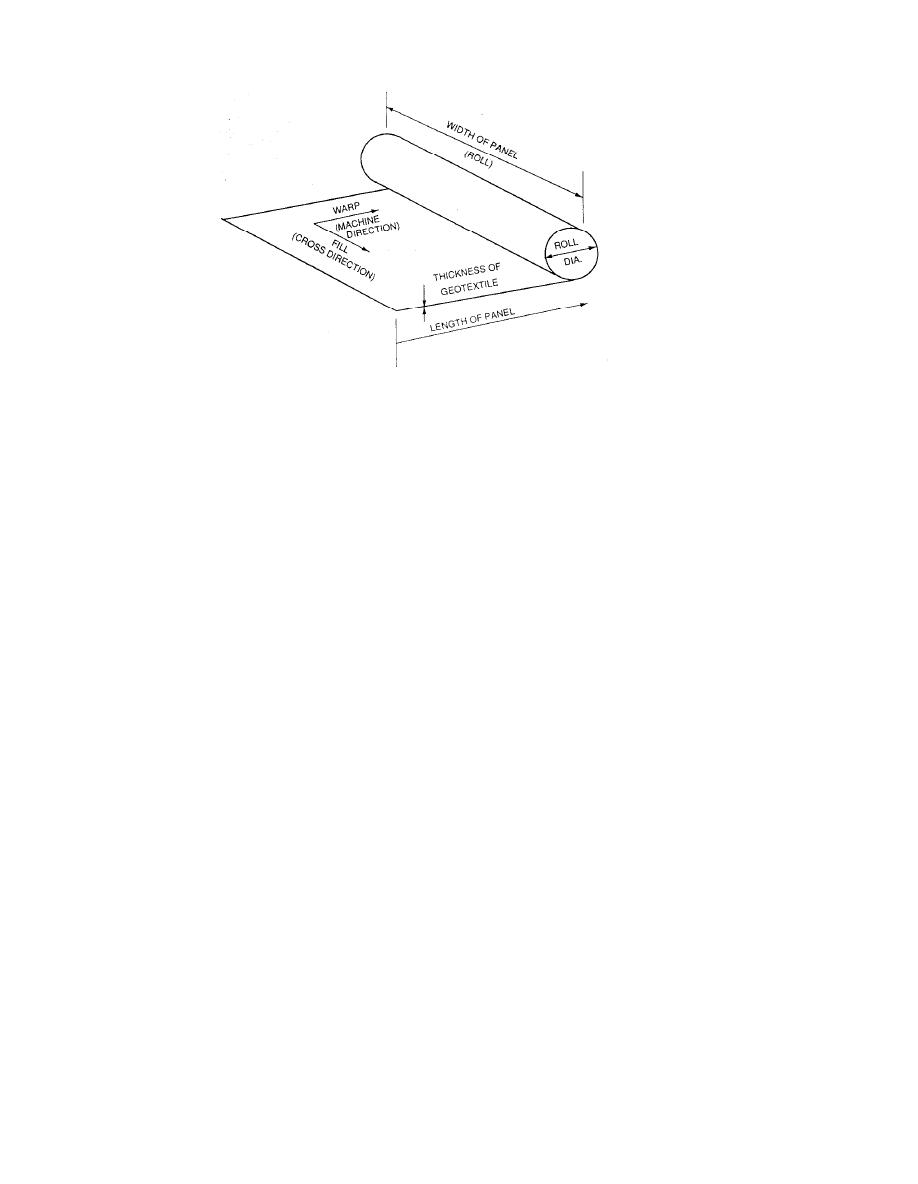
TM 5-818-8/AFJMAN 32-1030
Figure 1-1. Dimensions and Directions for Woven Geotextiles.
rating fibers of the same polymer type but having
material cannot easily be periodically inspected or
different melting points in the mat, or by using
easily replaced if it should become degraded (for
heterofilaments, that is, fibers composed of one
example filtration and/or drainage functions
type of polymer on the inside and covered or
within an earth dam), current practice is to use
sheathed with a polymer having a lower melting
only geologic materials (which are orders of magni-
point. A heat-bonded geotextile is shown in figure
tude more resistant to these weathering effects
l-6.
than polyesters).
1-6. Seam Strength
the fiber mat, coating the fibers and bonding the
a. Joining Panels. Geotextile sections can be
contacts between fibers.
joined by sewing, stapling, heat welding, tying,
(d) Combination bonding. Sometimes a com-
and gluing. Simple overlapping and staking or
bination of bonding techniques is used to facilitate
nailing to the underlying soil may be all that is
manufacturing or obtain desired properties.
necessary where the primary purpose is to hold
(4) Composite geotextiles are materials which
the material in place during installation. However,
combine two or more of the fabrication techniques.
where two sections are joined and must withstand
The most common composite geotextile is a non-
tensile stress or where the security of the connec-
woven mat that has been bonded by needle punch-
tion is of prime importance, sewing is the most
ing to one or both sides of a woven scrim.
reliable joining method.
1-5. Geotextile Durability
b. Sewn Seams. More secure seams can be pro-
duced in a manufacturing plant than in the field.
Exposure to sunlight degrades the physical proper-
The types of sewn seams which can be produced in
ties of polymers. The rate of degradation is re-
the field by portable sewing machines are pre-
duced by the addition of carbon black but not
sented in figure 1-7. The seam type designations
eliminated. Hot asphalt can approach the melting
are from Federal Standard 751. The SSa seam is
point of some polymers. Polymer materials become
referred to as a "prayer" seam, the SSn seam as a
brittle in very cold temperatures. Chemicals in the
"J" seam, and the SSd as a "butterfly" seam. The
groundwater can react with polymers. All poly-
double-sewn seam, SSa-2, is the preferred method
mers gain water with time if water is present.
for salvageable geotextiles. However, where the
High pH water can be harsh on polyesters while
edges of the geotextile are subject to unraveling,
low pH water can be harsh on polyamides. Where
SSd or SSn seams are preferred.
a chemically unusual environment exists, labora-
c. Stitch Type. The portable sewing machines
tory test data on effects of exposure of the geotex-
used for field sewing of geotextiles were designed
tile to this environment should be sought. Experi-
as bag closing machines. These machines can
ence with geotextiles in place spans only about 30
produce either the single-thread or two-thread
years. All of these factors should be considered in
chain stitches as shown in figure l-8. Both of
selecting or specifying acceptable geotextile mate-
these stitches are subject to unraveling, but the
rials. Where long duration integrity of the mate-
single-thread stitch is much more susceptible and
rial is critical to life safety and where the in-place
1-2


 Previous Page
Previous Page
